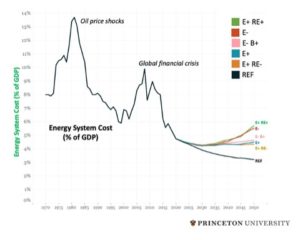By David Gardiner, President, and David Landolfi, DGA 2021 Winter Intern
Two recent reports from the National Academies of Sciences, Engineering, and Medicine (the Academies) and Princeton University outline key steps the United States should take in the coming decade to set the country on a successful path to net-zero carbon emissions by 2050. Four insights emerge from these studies, which can help the many corporations and other large institutions that are already reducing their emissions and committed to do more, chart a path forward. These insights reinforce many of the points I made in my earlier blog post on the legislative landscape.
Insight #1: Decarbonization is technologically feasible and will bolster the American economy. Both studies call for at least $2 trillion in capital investment over the next decade, but they argue that this is in line with historic energy expenditure. In the Princeton study, decarbonization models show that the transition would cost an annual four to six percent of its GDP annually, significantly less than the global financial crisis or the oil price shocks of the 1970s. The Academies find that net costs would be on the order of $100-300 billion when taking into account improved efficiency, lower operating costs, and health benefits attributed to clean energy. This investment would prioritize expanding our clean energy infrastructure using already-proven technologies.
Modeled annual energy-system costs as percentage of GDP are comparable to (or less than) recent energy-system costs, but higher than REF

Source: Princeton University. “Net-Zero America: Potential Pathways, Infrastructure, Impacts.”
Clean energy infrastructure projects over the next decade are expected to create as many as 2 million new jobs, primarily in manufacturing and construction. Clean energy job growth will more than offset losses in the fossil fuel industry, creating up to 1 million net jobs by 2030, according to Princeton. A clean energy future would benefit the economy in a variety of other ways, such as improving resilience, national security, quality of life, and lowering energy costs. The Academies recommend the establishment of a federal Green Bank, which would finance low- or zero-carbon businesses and infrastructure projects.
Insight #2: Infrastructure, renewables, and efficiency present best options for essential Immediate action. The Academies and Princeton have many technological recommendations for achieving a cost-efficient and rapid transition across all relevant sectors. Below are three pertinent goals for 2030:
- Double production of carbon-free electricity to at least 70 percent. As the electrification of the building, industry, and transportation sectors accelerates, a growth in demand should be met with renewable capacity. Princeton estimates the U.S. will need to triple wind capacity and quadruple solar capacity by 2030 to remain on an achievable net-zero path.
- Plan and build critical infrastructure. As demand for clean electricity rises, infrastructure is needed to connect regions of low-cost generation to areas with large energy consumption. The studies argue transmission capacity will have to increase by 40-60 percent by 2030. To electrify transportation, Princeton projects at least 3 million new public charging ports are required across the country by 2030, up from 78,500 today. Both studies also agree the country needs to accelerate its the deployment of carbon capture technologies and begin construction of a nationwide CO2 transportation network.
- Improve energy efficiency while reducing energy intensity. The buildings and industrial sectors account for more than half of U.S. direct greenhouse gas emissions, have been historically difficult to decarbonize, and have received little policy maker attention. Congress could reduce total energy use in new buildings by 50 percent by 2030 by setting more stringent standards for zero-emission appliances. The industrial sector should employ energy efficient equipment such as combined heat and power generation, as well as electrify processes where possible.
Insight #3: The transition to net-zero must be fair and equitable. Public participation in decision-making is crucial to ensuring historically marginalized communities and regions reliant on the fossil fuel economy aren’t left behind. A shift to net-zero by 2050 could avoid 300,000 premature deaths, but the country must guarantee these benefits are enjoyed equally. The Academies call for the establishment of an Office of Equitable Energy Transitions within the White House, which would develop and report on energy equity indicators. Additionally, education and training programs should be established that align with a net-zero workforce.
Insight #4: The expansion of RD&D is crucial. While significant near-term emission cuts can be made with existing technology, development of nascent technologies is necessary to achieve our 2050 decarbonization goals. Both studies acknowledge that fossil fuels will likely remain in the energy resource mix by midcentury, but their impact will largely depend on the rate of innovation. Hydrogen has the potential to blend into fuels and increase their energy content, yet storage remains a significant challenge. Advancement of carbon capture could also help mitigate emissions from sectors particularly difficult to decarbonize. The Academies recommend tripling federal investment in clean energy RD&D over the next decade. The faster these technologies are proven, the more time the country will have for scaling and deployment.
The studies’ recommendations for improved transmission and charging infrastructure, scaling up of renewable energy, increased energy efficiency, and renewable thermal RD&D aligns with many clean energy goals of the private sector. As net-zero efforts continue to accelerate within the private sector, studies like these show the path forward which policy makers and the private sector should be implementing together and where the most significant points of collaboration on policy exist.
